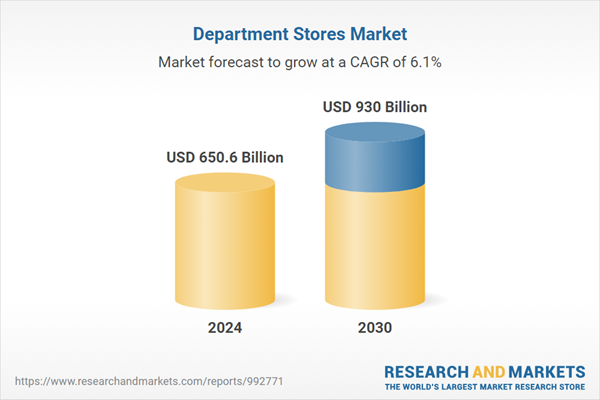Global Department Stores Market - Key Trends and Drivers Summarized
How Do Department Stores Operate and What Sets Them Apart from Other Retail Formats?
Department stores are large-scale retail establishments offering a wide variety of goods organized into distinct departments, each specializing in different categories such as apparel, home goods, electronics, beauty products, and more. They operate on a unique model that combines the breadth of product offerings found in specialty stores with the convenience of a one-stop shopping experience. Typically, these stores are strategically located in prime urban areas, shopping malls, or high-traffic retail districts, making them accessible to a broad consumer base. Department stores are distinguished by their focus on providing a well-curated assortment of merchandise from both high-end and mid-tier brands, creating a multi-category shopping experience that appeals to a wide range of demographics. Unlike big-box stores that focus primarily on price and efficiency, department stores emphasize customer service, ambiance, and brand selection, often incorporating personal styling services, on-site cafes, and experiential retail elements to enhance the overall shopping experience. This blend of convenience, variety, and premium services allows department stores to occupy a unique niche within the retail ecosystem, catering to customers who value choice and quality along with an immersive shopping experience. Additionally, department stores often serve as anchor tenants in shopping centers, drawing foot traffic that benefits surrounding retailers, which underscores their pivotal role in the broader retail infrastructure.Why Have Department Stores Struggled in Recent Years and What Are They Doing to Adapt?
The decline of department stores in recent years has been driven by a combination of changing consumer behavior, the rise of e-commerce, and increased competition from fast fashion and specialty retailers. With the advent of online shopping, consumers have shifted towards convenience and competitive pricing, making it challenging for traditional department stores to retain their market share. Additionally, the rapid expansion of big-box retailers and direct-to-consumer brands has eroded the competitive advantage of department stores in terms of variety and price. The COVID-19 pandemic further exacerbated these challenges, leading to widespread store closures, reduced foot traffic, and a reevaluation of business models. In response, many department stores have adopted multi-pronged strategies to adapt and stay relevant. One major initiative has been the integration of digital channels with brick-and-mortar operations to create an omnichannel shopping experience. Stores like Nordstrom and Macy’s have invested heavily in upgrading their e-commerce platforms, launching mobile apps, and implementing services like “buy online, pick up in store” (BOPIS) to bridge the gap between online and offline shopping. Others, like Saks Fifth Avenue and Neiman Marcus, have focused on elevating their luxury segments and offering exclusive products and experiences that cannot be replicated online. Another adaptation has been the reimagining of physical spaces to emphasize experiential retail, transforming sections of their stores into pop-up shops, interactive zones, and event spaces to attract a younger, experience-driven audience. Additionally, some department stores have entered into strategic partnerships with popular brands, utilizing store-within-a-store concepts to refresh their image and attract brand-conscious shoppers.What Innovations Are Transforming the Future of Department Stores?
Recent innovations are reshaping the traditional department store model by focusing on technology integration, sustainability, and a renewed emphasis on customer experience. One of the most significant shifts has been the adoption of advanced digital tools to enhance both operational efficiency and customer engagement. Artificial intelligence (AI) and machine learning are being employed to personalize the shopping experience through sophisticated recommendation engines, while data analytics are used to optimize inventory management and tailor product assortments based on local preferences. Virtual and augmented reality (VR and AR) technologies are also being leveraged to create immersive experiences, such as virtual fitting rooms and 3D store tours, allowing customers to explore product offerings and visualize purchases without physically visiting the store. Moreover, many department stores are embracing the trend of sustainability, incorporating eco-friendly practices into their supply chains and promoting ethically sourced merchandise. For instance, some stores are introducing “green” product lines, highlighting brands that prioritize sustainable production and offering recycling programs for textiles and electronics. In addition, the use of energy-efficient lighting, renewable energy sources, and smart building technologies is being implemented to reduce the environmental impact of large retail spaces. On the experiential front, department stores are experimenting with hybrid formats that blend retail with entertainment and hospitality. Flagship locations are being redesigned to include coworking spaces, art installations, and gourmet food halls, turning them into lifestyle destinations rather than just shopping venues. This convergence of retail and leisure is aimed at attracting a new generation of consumers who seek more than just products - they want unique experiences that blend seamlessly with their social and cultural interests. Furthermore, pop-up shops and limited-edition collaborations are being used to create a sense of exclusivity and urgency, drawing customers into physical stores for products and experiences that are unavailable online.What’s Fueling the Expansion and Resilience of the Department Store Market?
The growth and resilience of the department store market are driven by several factors, including the ongoing evolution of consumer preferences, the rise of hybrid shopping models, and the strategic reinvention of physical store spaces. A key driver is the growing trend towards experiential retail, where customers are increasingly valuing in-store experiences that offer more than just products. This shift has encouraged department stores to focus on creating destination shopping environments that combine entertainment, dining, and social engagement, making them appealing to shoppers seeking leisure and convenience in a single location. Another major factor is the expansion of omnichannel strategies, where department stores are blending digital and physical shopping experiences to meet the needs of modern consumers. With the growth of e-commerce, department stores are investing in technologies like AI-powered chatbots, virtual styling assistants, and seamless checkout systems to offer a frictionless shopping experience that spans online and offline channels. This integration of digital tools has not only enhanced customer engagement but also enabled stores to capture valuable consumer data, allowing for more effective personalization and targeted marketing. Additionally, department stores are increasingly embracing sustainability as a core component of their value proposition, responding to the growing demand for environmentally responsible retail. This has led to initiatives such as the introduction of eco-friendly product lines, partnerships with sustainable fashion brands, and the adoption of circular economy practices like clothing rental and resale services. The shift towards sustainable retail is particularly appealing to younger generations, who are more likely to support brands with strong ethical and environmental commitments. Furthermore, the post-pandemic recovery has highlighted the importance of physical retail as a complement to digital channels, with consumers returning to stores for the tactile, immediate shopping experience that online platforms cannot fully replicate. This has prompted department stores to invest in reconfiguring their layouts, offering flexible spaces for community events, and experimenting with new store formats like smaller, urban-centric locations. Together, these factors are not only sustaining the relevance of department stores but also positioning them for growth in a rapidly changing retail landscape that values both innovation and tradition.Report Scope
The report analyzes the Department Stores market, presented in terms of units. The analysis covers the key segments and geographic regions outlined below.Segments: Segment (Department Stores).
Geographic Regions/Countries: World; United States; Canada; Japan; China; Europe (France; Germany; Italy; United Kingdom; Spain; Russia; and Rest of Europe); Asia-Pacific (Australia; India; South Korea; and Rest of Asia-Pacific); Latin America (Argentina; Brazil; Mexico; and Rest of Latin America); Middle East (Iran; Israel; Saudi Arabia; United Arab Emirates; and Rest of Middle East); and Africa.
Regional Analysis
Gain insights into the U.S. market, valued at $168.5 Billion in 2024, and China, forecasted to grow at an impressive 9.4% CAGR to reach $218.0 Billion by 2030. Discover growth trends in other key regions, including Japan, Canada, Germany, and the Asia-Pacific.Why You Should Buy This Report:
- Detailed Market Analysis: Access a thorough analysis of the Global Department Stores Market, covering all major geographic regions and market segments.
- Competitive Insights: Get an overview of the competitive landscape, including the market presence of major players across different geographies.
- Future Trends and Drivers: Understand the key trends and drivers shaping the future of the Global Department Stores Market.
- Actionable Insights: Benefit from actionable insights that can help you identify new revenue opportunities and make strategic business decisions.
Key Questions Answered:
- How is the Global Department Stores Market expected to evolve by 2030?
- What are the main drivers and restraints affecting the market?
- Which market segments will grow the most over the forecast period?
- How will market shares for different regions and segments change by 2030?
- Who are the leading players in the market, and what are their prospects?
Report Features:
- Comprehensive Market Data: Independent analysis of annual sales and market forecasts in US$ Million from 2024 to 2030.
- In-Depth Regional Analysis: Detailed insights into key markets, including the U.S., China, Japan, Canada, Europe, Asia-Pacific, Latin America, Middle East, and Africa.
- Company Profiles: Coverage of players such as Amart Furniture, Bergdorf Goodman, Bi-Mart, Bloomingdale's, Bucherer Montres S.A. and more.
- Complimentary Updates: Receive free report updates for one year to keep you informed of the latest market developments.
Some of the 102 companies featured in this Department Stores market report include:
- Amart Furniture
- Bergdorf Goodman
- Bi-Mart
- Bloomingdale's
- Bucherer Montres S.A.
- Chongqing Department Store
- Elden's Fresh Foods & Media Solutions Corp.
- Farm Boy
- Genensis Luxury Fashion Pvt., Ltd.
- Goalpha Technologies Inc.
Tariff Impact Analysis: Key Insights for 2025
Global tariff negotiations across 180+ countries are reshaping supply chains, costs, and competitiveness. This report reflects the latest developments as of April 2025 and incorporates forward-looking insights into the market outlook.The analysts continuously track trade developments worldwide, drawing insights from leading global economists and over 200 industry and policy institutions, including think tanks, trade organizations, and national economic advisory bodies. This intelligence is integrated into forecasting models to provide timely, data-driven analysis of emerging risks and opportunities.
What’s Included in This Edition:
- Tariff-adjusted market forecasts by region and segment
- Analysis of cost and supply chain implications by sourcing and trade exposure
- Strategic insights into geographic shifts
Buyers receive a free July 2025 update with:
- Finalized tariff impacts and new trade agreement effects
- Updated projections reflecting global sourcing and cost shifts
- Expanded country-specific coverage across the industry
Table of Contents
Companies Mentioned (Partial List)
A selection of companies mentioned in this report includes, but is not limited to:
- Amart Furniture
- Bergdorf Goodman
- Bi-Mart
- Bloomingdale's
- Bucherer Montres S.A.
- Chongqing Department Store
- Elden's Fresh Foods & Media Solutions Corp.
- Farm Boy
- Genensis Luxury Fashion Pvt., Ltd.
- Goalpha Technologies Inc.
Table Information
| Report Attribute | Details |
|---|---|
| No. of Pages | 209 |
| Published | April 2025 |
| Forecast Period | 2024 - 2030 |
| Estimated Market Value ( USD | $ 650.6 Billion |
| Forecasted Market Value ( USD | $ 930 Billion |
| Compound Annual Growth Rate | 6.1% |
| Regions Covered | Global |









